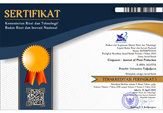Effect of Fobio on Intensity of Moler Disease (Fusarium oxysporum) on Various Shallot Cultivars
Abstract
Keywords
Full Text:
PDFReferences
Aini, DLQ. 2018. Kombinasi Trichoderma harzianum dan pupuk Mikoriza untuk mengendalikan penyakit moler pada tanaman bawang merah. Fakultas Pertanian Universitas Jember. http://repository.unej.ac.id/handle/123456789/86268
Badan Pusat Statistik. 2020. Produksi Tanaman Sayuran. BPS Jakarta. https://www.bps.go.id/indicator/55/61/2/produksi-tanaman-sayuran.html
Baswarsiati T, Sudaryono KB, Andri, & Purnomo S. 2015. Pengembangan varietas bawang merah potensial dari jawa timur. Inovasi Hortikultura Pengungkit Peningkatan Pendapatan Rakyat, 5(4), 1-16. http://hortikultura.litbang.pertanian.go.id/Buku_ Inovasi/Inovasi Hortikultura.pdf
Edi S. 2019. Pertumbuhan dan hasil beberapa varietas bawang merah pada dua cara tanam di lahan kering dataran rendah Kota Jambi. Jurnal Agroecotania: Publikasi Nasional Ilmu, 2(1), 1–10. https://doi.org/10.22437/agroecotania.v2i1.7899
Hartati S, Nur’haqi RY, Natawigena WD, & Suganda T. 2022. Potency of yeasts isolated from shallot rhizosphere to control basal rot (Fusarium oxysporum f.sp. cepae) disease on shallot. CROPSAVER - Journal of Plant Protection, 5(1), 23. https://doi.org/10.24198/cropsaver.v5i1.38099
Hasyidan G, Wiyatiningsih S. & Suryaminarsih P. 2021. Aplikasi biopestisida fobio dan Streptomyces sp. untuk mengendalikan penyakit moler pada tanaman bawang merah. Jurnal Agrohita, 6(2), 168–173. http://dx.doi.org/10.31604/jap.v6i2.4855
Isniah, US, & Widodo. 2015. Eksplorasi fusarium nonpatogen untuk pengendalian penyakit busuk pangkal pada bawang merah. Fitopatologi, 11, 14–22. https://doi.org/10.14692/jfi.13.1.14
Jasmi E, Sulistyaningsih, & Indradewa D. 2013. Pengaruh vernalisasi umbi terhadap pertumbuhan, hasil, dan pembungaan bawang merah (Allium cepa L. Aggregatum group) di dataran rendah. Ilmu Pertanian (Agricultural Science), 16(1), 42–57. https://doi.org/10.22146/ipas.2525
Juwanda M, Khotimah K, & Amin M. 2016. Peningkatan ketahanan bawang merah terhadap penyakit layu fusarium melalui induksi ketahanan dengan asam salisilat secara In vitro. Agrin, 20(1), 15–28. http://dx.doi.org/10.20884/1.agrin.2016.20.1.310
Kaary K, Rumahlewang W, & Tuhumury GNC. 2022. Kejadian penyakit pada tanaman bawang merah ( Allium cepa ) di pulau lakor kabupaten maluku barat daya. Kalwedo Sains, 3(1), 1–7. https://doi.org/10.082022/kalwedosains.v3i1.5395
Kartinaty T, Hartono, & Serom. 2018. Penampilan pertumbuhan dan produksi lima varietas bawang merah ( Allium ascalonicum ) di kalimantan barat. Buana Sains, 18(2), 103. https://doi.org/10.33366/bs.v18i2.1183
Kasim N, Haring F, Asis B, & Amin AR. 2021. Pertumbuhan dan produksi tiga varietas bawang merah (Allium ascalonicum L.) pada berbagai konsentrasi bioslurry cair. Jurnal Agrivigor, 12(1), 18–28. https://journal.unhas.ac.id/index. php/agrivigor/article/view/14317
Nugraheni ES. 2010. karakterisasi biologi isolat-isolat fusarium sp. pada tanaman cabai merah ( Capsicum annuum L .) asal boyolali. In Skripsi. Surakarta: Fakultas Pertanian Universitas Sebelas Maret. https://digilib.uns.ac.id/dokumen/14884
Nurhayati. 2011. Epidemiologi Penyakit Tumbuhan. Universitas Sriwijaya Press.
Prakoso EB, Wiyatingsih S, & Nirwanto H. 2016. Uji ketahanan berbagai kultivar bawang merah ( Allium ascalonicum ) terhadap infeksi penyakit moler ( Fusarium oxysporum f . sp . cepae ). Plumula, 5(1), 10–20. http://ejournal.upnjatim.ac.id/index.php/plumula/article/view/773
Prasetyo MSH, Masnilah R, & Wagiyana. 2017. Kajian intensitas penyakit bercak coklat pengendaliannya pada padi ( Oryza sativa L .) di kabupaten jember. Gontor Agrotech Science Journal, 3(2), 59–83. https://doi.org/10.21111/agrotech.
Pratiwi AH. 2018. Uji efektivitas fungisida propineb 70% terhadap penyakit bercak ungu yang disebabkan oleh jamur Alternaria Porri Pada tanaman bawang merah dan pengaruhnya terhadap jamur filosfer secara in vitro. Doctoral Disertation. Universitas Brawijaya, Malang. http://repository.ub.ac.id/id/eprint/13528
Rahayu DR, Wiyatiningsih S, & Suryaminarsih P. 2021. pengaruh perendaman bibit bawang merah dengan formulasi biopestisida untuk mengendalikan penyakit moler (Fusarium oxysporum). Agritrop : Jurnal Ilmu-Ilmu Pertanian (Journal of Agricultural Science), 19(2), 121–129. https://doi.org/10.32528/agritrop.v19i2.6337
Rahayu YS. 2013. Pengaruh waktu penanaman terhadap pertumbuhan dan hasil beberapa varietas tanaman bawang merah (Allium ascalonicum L.). Agromix, 4(1), 38–46. https://doi.org/10.35891/agx.v4i1.777
Rojikin, MK, Wiyatiningsih S, & Sriharijani W. 2021. Formula biopestisida sebagai pengendali dan penginduksi ketahanan kultivar jeruk pamelo (Citrus maxima (Burm.) Merr) terhadap penyakit blendok skripsi. Outher Thesis Upnv Jatim, 44–54. http://sna.upnjatim.ac.id/index.php/sna/article/view/7/7
Supriyadi A, Rochdjatun I, & Djauhari S. 2013. Kejadian penyakit pada tanaman bawang merah yang dibudidayakan secara vertikultur di sidoarjo. Jurnal HPT, 1(3), 27–40. http://jurnalhpt.ub.ac.id/index.php/jhpt/article/viewFile/31/40
Suryaminarsih P, & Mujoko T. 2020. Competition of biological agents of Streptomyces sp, Gliocladium sp, and Trichoderma harzianum to Fusarium oxysporum in Tomato Rhizophere. CROPSAVER - Journal of Plant Protection, 3(1), 17. https://doi.org/10.24198/cropsaver.v3i1.24173
Wiyatiningsih S. 2011. Populasi Fusarium oxysporum F.Sp. cepae, intensitas penyakit moler, dan hasil umbi bawang merah di tiga daerah sentra produksi. UPN University Press. http://eprints.upnjatim.ac.id/id/eprint/3249
Wiyatiningsih S, & Sukaryorini P. 2009. Peningkatan Hasil dan Ketahanan Kultivar Bawang Merah terhadap Fusarium oxysporum f.sp. cepae Penyebab Penyakit Moler Menggunakan Formula Suspensi Mikroorganisme. Prosiding Seminar Nasional HPTI. 75–80. http://eprints.upnjatim.ac.id/id/eprint/3214
Wiyatiningsih S, Wibowo A, & Prasetyawati ET. 2009. Keparahan penyakit moler pada enam kultivar bawang merah karena infeksi fusarium oxysporum di tiga daerah sentra produksi. Seminar Nasional: Akselerasiss Pengembangan Teknologi Pertanian Dalam Mendukung Revitalisasi Pertanian, 47(2), 10–13. http://eprints.upnjatim.ac.id/3142/
DOI: https://doi.org/10.24198/cropsaver.v6i2.45747
Refbacks
- There are currently no refbacks.
Copyright (c) 2023 CROPSAVER - Journal of Plant Protection
2019 © Publisher by Department of Plant Pests and Diseases, Universitas Padjadjaran
In Collaboration With
Centre for Product Development and Partnership Study (Puspromit)
Indonesian Entomological Society (PEI) and
Indonesian Phytopathological Society (PFI)
Chapter Bandung

This work is licensed under a Creative Commons Attribution-NonCommercial 4.0 International License.









